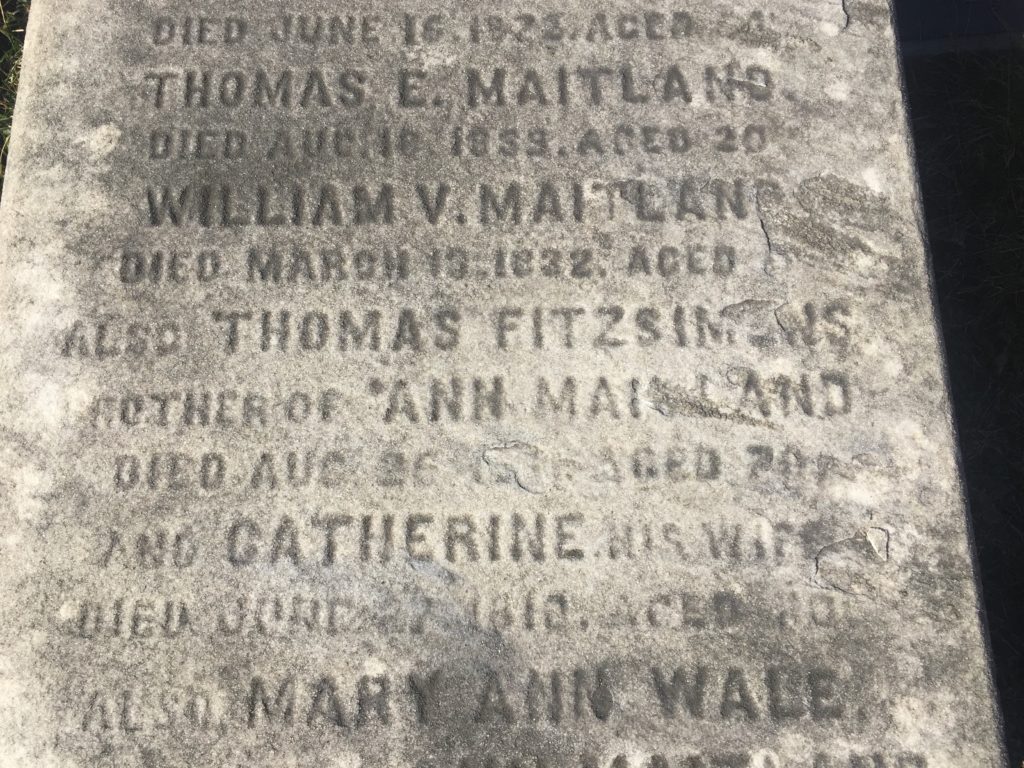Erik Visits an American Grave, Part 1,073
This is the grave of Thomas Fitzsimmons.

Born in County Wicklow, Ireland, in 1741, Fitzsimmons immigrated to Philadelphia as a young man, married a woman named Catherine Meade and went into business with his new brother-in-law, George Meade. The West Indies Trading Company became a key business in the triangular trade, which of course included the slave trade. That’s how northerners got rich after all that Fitzsimmons would become a rich guy.
Fitzsimmons might have made a lot of money off the colonial system, but he was a committed independence activist as the American Revolution began. Much of the reason for this is that merchants were who got screwed the most by the various revenue raising acts the British placed on the colonies to pay for the wars of genocide settlers kept starting on the frontier. He put together some home guards that played an important supporting role in the Battle of Trenton and helping manage Washington’s retreat out of New York by serving as a force to hold off British advances. Fitzsimmons was a critical figure in the raising of money for the troops, a huge problem given the terrible governing body that the Articles of Confederation had created. So Fitzsimmons was on the Philadelphia Council of Safety in order to build up defenses for the city and he personally donated a lot of money to feed and clothe soldiers. After the British pulled out of Pennsylvania to focus on the South and the French assistance to the colonies, Fitzsimmons’ active role in fighting was over and he focused on politics and business exclusively after 1778.
In 1786, Fitzsimmons was elected to the Continental Congress. By this time, it was obvious that the Articles of Confederation were a disaster and Fitzsimmons became a strong advocate for throwing them out and starting over with something better. He became an advocate for a strong central government in the Constitutional Convention. He also wanted the Convention to outlaw slavery, despite his personal stake in it. Incidentally, a strong Catholic, Fitzsimmons was one of only three signers of the Constitution who were Catholics.
Fitzsimmons became a very strong Federalist and served three terms in the new U.S. Congress, from 1789-95. It’s hardly surprising he became a Federalist, as he was a banker who worked closely with Robert Morris and the other financial elite of the Early Republic. In Congress, he played a relatively minor role. Perhaps his biggest contribution was chairing the commission that looked into the American government’s genocidal campaign against the tribes in 1791, which established the position that Congress had power in the handling of war affairs. But he lost his reelection bid in 1794. This was a disaster for the Federalists. See, yellow fever came and ripped through Philadelphia that summer. Almost all the rich people, probably including Fitzsimmons, got out of the city, leaving the poorer residents to die. Several leading Jeffersonians however stayed in the city and doctored the sick. For the city’s residents, this made the Federalists look out of touch. This once fairly strong Federalist city became a Jeffersonian stronghold and really helped shift American politics toward Jefferson’s point of view. So Fitzsimmons lost his seat in the aftermath of the yellow fever epidemic.
In the aftermath of his political career, Fitzsimmons just became a rich guy doing rich guy things. He did have one more major task though. John Adams appointed him as part of the commission to work out the party of the Jay Treaty that required the U.S. to examine the claims of American Tories who lost their assets and were unable to collect debts during the Revolution. But the Americans felt that the British were vastly inflating the total amount of the debts and they just walked away in 1799. This issue finally got resolved in 1802 when the U.S. paid the British a chunk of money and told them to deal with the debts after that.
Fitzsimmons was a trustee of the University of Pennsylvania, became a bank director, and organized a large insurance company. He pushed for the rechartering of the Bank of the United States when Jefferson was unwilling to do so. He strongly opposed Jefferson’s ridiculous Embargo, which just shut off all trade with both Britain and France and is one of the worst foreign policy decisions in American history. Like a lot of this generation, Fitzsimmons suffered financial setbacks later in life as the sketchy financial system of the United States, plus all the speculation that these guys engaged in, undercut his wealth. He died in 1811, at the age of 69.
Thomas Fitzsimmons is buried at St. Mary’s Catholic Church, Philadelphia, Pennsylvania.
If you would like this series to visit other signers of the Constitution, you can donate to cover the required expenses here. George Read is in New Castle, Delaware and William Samuel Johnson is in Stratford, Connecticut. Previous posts in this series are archived here.


